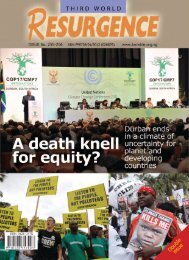Plantations, poverty and power - Critical Information Collective
Plantations, poverty and power - Critical Information Collective
Plantations, poverty and power - Critical Information Collective
Create successful ePaper yourself
Turn your PDF publications into a flip-book with our unique Google optimized e-Paper software.
64<br />
Botnia, Uruguay: Monocultures, pollution fears <strong>and</strong> an international dispute<br />
The US$1.2 billion Botnia pulp mill is the largest single foreign investment in Uruguay’s history. 316 Built<br />
on the Uruguay River at Fray Bentos, the plans for the pulp mill led to massive protests in Argentina <strong>and</strong><br />
Uruguay. Spanish company ENCE also planned to build a pulp mill near Fray Bentos, but relocated its<br />
pulp mill to Colonia in the south-west of Uruguay, as a result of the protests. 317<br />
The Argentinian government was so concerned about pollution from the mill that it took Uruguay to the<br />
International Court of Justice (ICJ) in the Hague. In July 2006, the ICJ ruled against Argentina. But this<br />
first ruling only stated that the court could not order a halt to construction of the pulp mills because there<br />
was no immediate danger. In other words, any pollution would happen once the pulp mill starts<br />
operations <strong>and</strong> the court cannot rule on something that has not yet happened. 318 It will take the ICJ several<br />
years to reach a decision about whether the construction of the pulp mill violates the 1975 Uruguay River<br />
Treaty. Under the treaty, either country has to inform the other about any developments which might have<br />
an impact on the river, before the project starts. In the case of the Botnia pulp mill, Uruguay did not do<br />
so, claims Argentina.<br />
The pollution from the pulp mill has received much attention internationally. Less discussed is the fact<br />
that the pulp mill sources its raw material from thous<strong>and</strong>s of hectares of eucalyptus plantations, which are<br />
drying up streams <strong>and</strong> leaving communities without water supplies.<br />
Botnia is a Finnish company, owned by the Metsäliitto Group (a cooperative of Finnish forest owners, 53<br />
per cent) <strong>and</strong> UPM Kymmene (47 per cent). 319 Despite the controversy, the pulp mill received a series of<br />
subsidies from European bilateral institutions as well as from the World Bank. In November 2006, the<br />
International Finance Corporation agreed to finance the project, giving a green light to other financiers to<br />
get involved.<br />
Lavish international subsidies<br />
Financing for Botnia’s pulp mill comes from the following sources of public money:<br />
•US$170 million from the International Finance Corporation;<br />
•US$350 million guarantee from the Multilateral Investment Guarantee Agency;<br />
•US$100 million reinsurance from Finnvera of MIGA’s guarantee;<br />
•USS$70 million from the Nordic Investment Bank;<br />
•US$230 million buyer credit guarantee from Finnvera;<br />
•US$7 million from Finnfund to Botnia’s plantation subsidiary Forestal Oriental.<br />
When IFC announced its support for the pulp mill, Erkki Varis, Botnia’s CEO <strong>and</strong> President, wrote that<br />
316 “URUGUAY: World Bank gives go ahead to Botnia mill”, Brazil Report, 24 October 2006.<br />
317 “Ence’s Relocation of New Uruguay Mill Settles Dispute with Argentina“, TAPPI, 13 December 2006.<br />
http://www.tappi.org/s_tappi/doc.aspCID=183&DID=553739<br />
318 “Uruguay welcomes World Bank report on paper mills bordering Argentina”, Xinhua General News Service, 14<br />
October 2006.<br />
319 “Oy Metsä-Botnia Ab”, Botnia website: http://www.botnia.com/en/default.asppath=204,208,225















